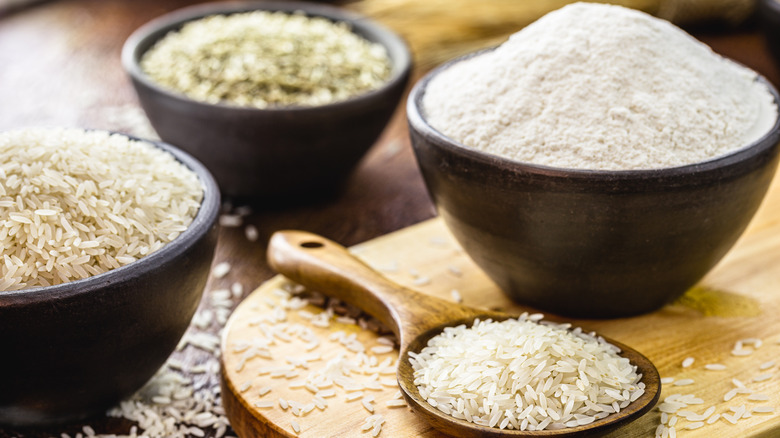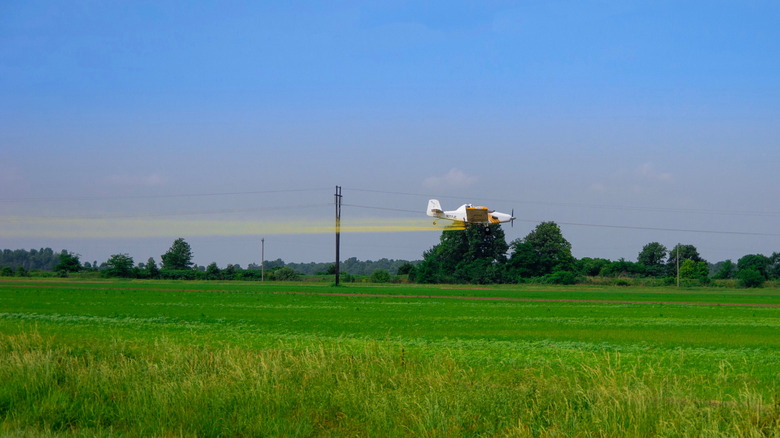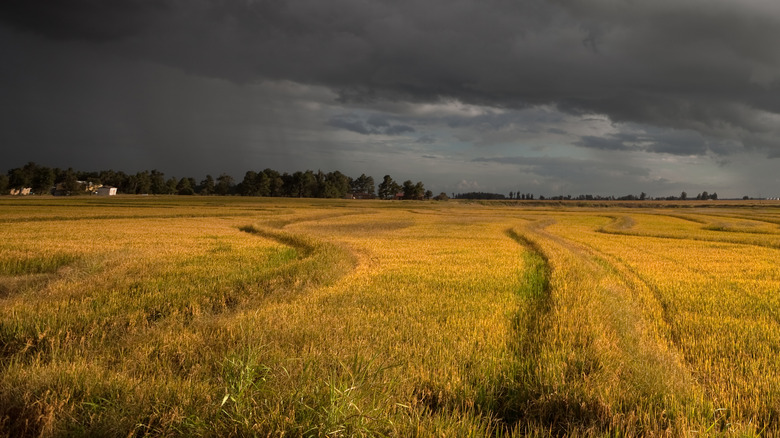This U.S. State Produces The Most Rice
It would be difficult to overestimate the importance of rice in cuisine, worldwide. As noted by Encyclopedia Britannica, this starchy cereal grain is a staple crop for roughly half of all humanity. This is especially true in East and Southeast Asia, and to a lesser extent, the Middle East. South America and sub-Saharan Africa, per the USDA, are also counted among the top regions for rice consumption. Globally, from side dishes to entrees, rice is an extremely common ingredient in cereals, noodles, and soups, plus many other hearty recipes. Rice can even be used to make alcohol or flour — flexibility that further underlines its usefulness.
Despite this widespread popularity, rice can only grow under certain conditions. The grass this food comes from typically thrives on land submerged in water. However, the paddies that rice grows in must be drained prior to harvest. Favorable climates, meanwhile, range from tropical to temperate, with hot days, cool nights, and an abundance of sunlight. Therefore, Asia does most of the rice farming across the planet, although the Americas, Australia, and Europe do contribute a fair amount, as well.
The United States is the fifth biggest rice exporter in the international market, impressively enough, shipping out nearly half of its crop each year. Yet, just a small handful of regions produce the bulk of U.S. rice supplies. Furthermore, one specific state grows almost half of all U.S. rice.
The Land of Opportunity leads the nation
Four areas, in particular, raise a vast majority of U.S. rice. According to the USDA, California's Sacramento Valley stands alone as a rice powerhouse on the West Coast. Farther east, the Gulf Coast region of Louisiana and Texas grows plenty of the crop, and north of that area, farmers in the Mississippi Delta grow rice in several states like Mississippi and Missouri. The leading U.S. rice producer, though, is the Arkansas Grand Prairie. While a neighboring state specializes in beef, the so-called Natural State of Arkansas excels in rice production.
Arkansas, also nicknamed the Land of Opportunity, does indeed hold an abundance of agrarian potential. Per Statista, Arkansas was the foremost grower of U.S. rice as recently as 2021, producing over 90 million-hundredweight of the foodstuff — more than three times what California, the runner-up, produced. Louisiana, Missouri, Texas, and Mississippi respectively came in third, fourth, fifth, and sixth in this regard. As noted by the Arkansas Farm Bureau, the Natural State generates about 2/5 of all U.S. rice. The crop comes in several varieties and is concentrated in the eastern half of the state, running north-to-south, and border-to-border. Hundreds of millions of bushels are cultivated across a million acres each year. As a result, rice is the Land of Opportunity's top agricultural export and its second most valuable commodity, supporting thousands of jobs in rural communities and earning the state's economy billions of dollars a year.
How rice came to Arkansas
Rice has taken a long journey to get to Arkansas. According to the USDA, rice is thought to have come from Asia originally. The plant then gradually spread across the Old World, the Rice Association mentions, in the hands of explorers, merchants, and soldiers who brought seeds to far-flung places like Europe. Ships eventually brought rice to the New World, as well, allowing the fledgling United States to start a rice industry in its southern regions. Then, in the late 19th century, the Arkansas Farm Bureau explains, one Arkansas man named W.H. Fuller traveled to Louisiana, saw their rice farms, and decided to try growing the crop back home. It turned out to be a match made in heaven.
The Grand Prairie didn't become the center of U.S. rice production by accident. Native Americans had lived on and hunted in this vast, flat grassland for a long time, according to the Encyclopedia of Arkansas, but when American settlers arrived, they saw great potential in the Grand Prairie for pastureland. So, cattle, hay, and other plants became the focus there for quite a while. However, when Fuller brought in rice circa 1897, it turned out that the Arkansas climate and the dense clay of the Grand Prairie made it ideal for paddies. Arkansas farmers had already been searching for a reliably valuable crop, and therefore, the prairie land was plowed to make way for rice. Arkansas' modern rice industry proves just how effective that decision was.


